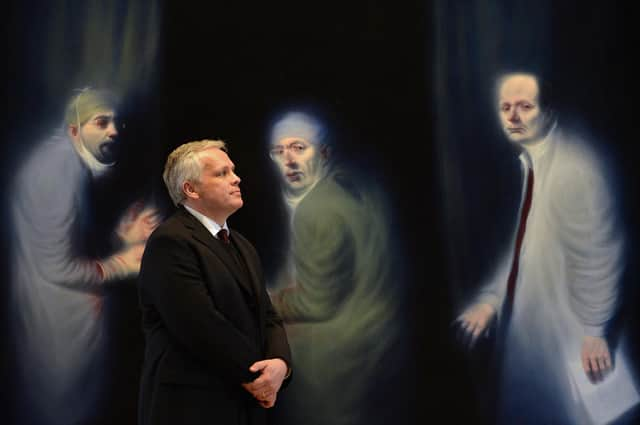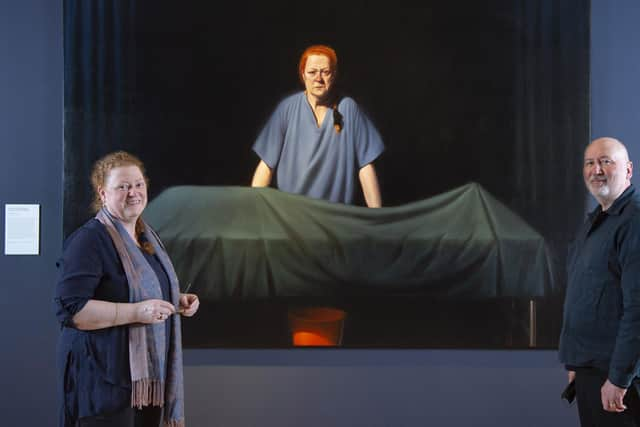Alexander McCall Smith: Photography has its place, but painted portraits provide a more evocative depiction of who we are


It is the work of a remarkable artist, Ken Currie, who sees himself as only an incidental portraitist, being more a painter of subjects with a political or social dimension.
Yet he has a strong interest in the human body, and this comes out in Three Oncologists, a portrait of three cancer specialists. The subjects emerge from the dark, much as do the figures in a painting by Caravaggio, looking out at us from the battlefield on which they struggle against disease. The effect is electrifying: this is a painting that it is impossible to look at without being struck by the sheer intensity of the artist’s vision.
Advertisement
Hide AdAdvertisement
Hide AdNow he has done it again, with a new work recently revealed in the same gallery. With his portrait of Professor Sue Black, the forensic anthropologist who has undertaken some of the most gruesome tasks of identification with which pathologists and anatomists are landed, this superb artist has again made the point that a portrait can do so much more than remind us what a particular person looked like.
This is a hundred miles away from conventional studio portraiture, where the subject simply looks out at us and not much is said about the human condition, about character, or about the world.
A portrait like this offers little comfort – at least on our first encounter with it. It is when we think about the deeper meaning that can be read into it, that we can take from it some consolation – in the case of the Currie portraits – that there are people who are prepared to do these demanding scientific tasks for the good of us all.
Portraiture is an extremely important branch of painting, and yet it does not get the attention it deserves. In some circles it is treated with a total lack of interest, bordering on condescension.


This is associated with the argument that the real task of the artist is to disturb us – to get us to question the world and the comfortable intellectual and emotional niches we make for ourselves. Art, in this view, is all about challenge, and portraiture simply does not afford sufficient opportunity to shake us out of complacency. Portraiture may also attract the criticism that it is too static, too limited in its possibilities, to allow the artist to do anything new.
Neither of these criticisms is justified. If you ignored the part played by portraiture in the history of Scottish art, you would be left with rather thin story, certainly when talking about earlier periods.
Scotland does not have a large patrimony of Renaissance art: the Reformation was iconoclastic, and much of our religious art was destroyed by zealots. Some examples survived – Roslin Chapel, with its intricate carvings is an example – and there was, of course, a beautiful, early native tradition in Celtic ornamentation. But we unfortunately had no Botticellis or Raphaels.
What we did develop, though, was a tradition of portraiture that could hold its head up in any company. Many earlier Scottish portraits were executed by continental artists who came to Scotland to work (an early example of cultural freedom of movement?), but then came home-grown talent in the shape of Jamesone, Ramsay and Raeburn.
Advertisement
Hide AdAdvertisement
Hide AdRamsay was one of the finest portrait painters of his time – anywhere – and in Raeburn’s delightful, fluid works new depths of feeling and sympathy were opened up in portraiture.
Raeburn’s Skating Minister is an example of how portrait painting can escape the confines of the studio and captivate a wide public. At one level, that is simply a rather whimsical picture of a man enjoying the ice on Duddingston Loch. At another it says a lot about what it was to be a minister in Scotland, about the certainty of belief (the minister is confident in his balance), about the social and psychological influence of the Church, and, pushing things a bit, about doing unexpected things – skating, for instance, in clerical garb.
The revolt against traditional painting in favour of conceptual art, with its private focus and its temporary installations, made portraiture look very old-fashioned.
Yet fashionable emperors often have no clothes, and while much contemporary conceptual art has shown itself to be readily forgettable, we obstinately have no difficulty in calling to mind the work of the Scottish colourists such as Peploe, of figurative artists such as Campbell, or socially engaged artists such as Ken Currie.
Portraiture still has wide appeal. New portraits of public figures really do have a constituency and deserve support.
One of the most popular portraits in the Scottish National Portrait Gallery is the haunting picture of the great crime novelist, Ian Rankin, by the Edinburgh portraitist, Guy Kinder. This hangs in the gallery’s coffee room and is admired by hundreds each day as they sip their coffee and eat their scones – both traditional Edinburgh pursuits.
Kinder portrays Rankin in the Oxford Bar, the haunt of his fictional detective, John Rebus. He captures perfectly the writer’s appealing, slightly brooding look, portraying just that amount of stubble expected of a successful crime writer. It is an utterly memorable picture that has a whole hinterland of atmosphere.
The same artist has also painted a contemporary Scottish heroine, Olivia Giles, who, after catastrophic amputations, set up a charity, 500 Miles, to make artificial limbs for countries where such things are often an unattainable luxury. That painting is a portrait of a remarkable woman – but it is also a statement about courage and determination and doing good in a suffering world.
Advertisement
Hide AdAdvertisement
Hide AdEach portrait is living history, the accumulation of posterity. If we omit to commission portraits of our Lord Provosts, Moderators and even those doing even very ordinary or thankless jobs, we do a great disservice to the richness of the historical record and deny the possibility of the portrait as great art. That is a pity. Photography has its place, but we need portraiture for a wider, more evocative depiction of who we are – and whom we might become.
A message from the Editor:
Thank you for reading this article. We're more reliant on your support than ever as the shift in consumer habits brought about by coronavirus impacts our advertisers.
If you haven't already, please consider supporting our trusted, fact-checked journalism by taking out a digital subscription.
Comments
Want to join the conversation? Please or to comment on this article.
